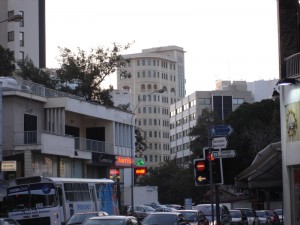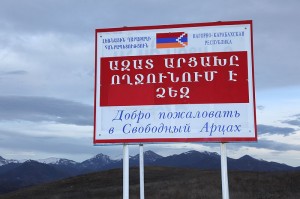Countries come in and out of existence around the world all the time. Look into history and you’ll find dozens of countries that were short-lived (some lasting only months). Today is no different. If you look at a world map today, you can find countries floating in a grey area between full-fledged country and autonomous region. Here are eight of those countries.
1. Transnistria (AKA Trans-Dniestr or Transdniestria)
After the USSR broke up, a territory dispute erupted in Moldova. War broke out briefly in 1992 and the territory/country broke away and formed a de facto state unrecognized by anyone in the United Nations. It’s a thin strip of land between the Dniester River and Ukraine with it’s own currency, flag and national anthem.
Russian influence in the region is widespread. Russian is spoken more frequently than Moldovan, Russia maintains 1200 peacekeeping troops in the region and there is even a statue of Lenin in the de facto capital, Tiraspol. There are many border crossings to get in, but if you go just make sure you have money for bribes at the border.
2. Western Sahara (Sahrawi Arab Democratic Republic)
During the collapse of European colonization after World War II, Spain withdrew from its colonies in Spanish Sahara. Spain ceded the region now known as Western Sahara to Morocco and Mauritania. However, the indigenous Sahrawi people rose up against the two countries. Mauritania withdrew from the region in 1979, but fighting with Morocco continued until a ceasefire was declared in 1991.
Today the region is cut in half with Morocco occupying one half and the Polisario movement (the liberation movement working towards independence) occupying the other half. A large wall runs down the entire length of the region separating the two. Entry into the region is difficult. Many travelers are turned away at the border. Entry into the SADR controlled region is almost entirely off limits to travelers.
Both of these regions lay inside Georgia in the Caucusus region and share similar history and backgrounds. As with Transnistria, these two regions erupted in territorial dispute with Georgia after the breakup of the USSR. War broke out first in South Ossetia between 1991 to 1992 and then Abkhazia between 1992 and 1993. Both regions are now mostly peaceful although war did break out again briefly in both regions in August 2008.
Both regions are recognized by Russia, Venezuela, Nicaragua and Nauru. However, Russia plays the most influence. There really isn’t much to see in either area and because war broke out recently, travel there isn’t recommended.
4. Somaliland
This region is in northern Somalia so it shares a lot of history with Somalia. When Italy left the region, Somaliland was briefly an independent country (for 5 days) until it joined with Somalia to form a country. After civil war broke out in 1991, it reasserted its independence. No country recognizes it, but many have informal ties with it. Somaliland is relatively peaceful compared with the southern part of the country and government rule with law enforcement is well-established.
Travel inside the country can be difficult since the Somaliland government requires all foreigners to have armed guards outside the main cities. Travel inside the region though is possible. A friend of mine has visited there several times. However, he is originally from the region so he knows friends there already and would blend in well.
5. Northern Cyprus
From 1967 to 1974, Greece was under a military dictatorship. In 1974 the Greek military dictatorship organized a coup on Cyprus that overthrew the Cypriot president Makarios III and installed Nikos Sampson in his place. At that time, Enosis (the idea of incorporating Cyprus to mainland Greece) was popular with Greek-Cypriots. However, since there is a sizeable minority of Turks on the island, Turkey invaded. The result is a northern Turk-controlled region recognized only by Turkey.
Travel to Northern Cyprus is relatively pain free. In fact, it may be the easiest of all the regions on this list to visit. Although the island is divided entirely from east to west by a UN buffer region, you can visit either side through the capital, Nicosia which lies in the divided buffer zone. While you’re at the capital, you can look around at the last divided capital in all of Europe.
Another territory in the Caucusus region that erupted in conflict after the USSR collapsed. Although the fighting started as early as 1988, fighting intensified in 1992 and lasted until 1994. The result is a region internationally recognized as controlled by Azerbaijan, but controlled by Armenia. The country is mostly safe as long as you stay away from the ceasefire line. Armed conflict between soldiers on both sides of this line has continued since the ceasefire.
The only country you can enter this region from is Armenia. In fact, if you show evidence on your passport of visiting Nagorno-Karabakh, you will be denied entrance to Azerbaijan even if you have a visa to enter the country. In some cases, people have even been arrested. To avoid this, you can ask that your visa be stamped on a separate piece of paper so no evidence of your visit appears on your passport.
7. Cabinda
Cabinda is a small exclave controlled by Angola. This region is the result of another European power leaving a colony in Africa. Portugal left Angola (then called Portuguese Congo) in 1974. It seceded Cabinda to Angola in a hotly disputed arrangement. Due to cultural and ethnic differences, Cabinda refuses to give up its independence to Angola. The region is dominated by Angola with only a government-in-exile for Cabinda operating out of Paris. A ceasefire between the Cabinda separatist forces and Angola was declared in 2006.
Until recently, travel to Cabinda was relatively safe. This changed in January 2010 when a Togo soccer team was traveling through the region and was attacked. Three people were killed and a new separatist movement claimed responsibility.
Travel to the region is still possible, but until safety measures increase, it isn’t advised.
8. Communitarian Nation of Moskitia
In 2002 a group of elders representing the Moskito people in eastern Nicaragua declared a plan to create a new nation. In August 2009, independence was declared. So far, no nation has recognized this region. In fact, Nicaragua hasn’t even made a formal response yet. There isn’t much information on travel to the region that I could find, but it shouldn’t be difficult for anyone who wants to go there.



I wasn’t aware of like any of these! I think the UN has trouble sometimes with countries that are recognized by some of the members and not recognized by others. Great post!
oh wow… i dont know about these place except northern cyprus… what about south sinai in egypt?
As far as I’ve read, the south sinai is a governate which is like a province of the country. I don’t think they’ve declared independence yet or are recognized as a country by anyone.
Interesting post. You can probably throw Quebec in there too 😉
Cam, I thought about including this one. They’ve been talking about independence for years there, but all I’ve really read is that they got a symbolic motion that they’re a nation. I thought that if I included this than I would have to include Alaska and Puerto Rico with similar movements.
Haha… just teasing! 😉
You’re right though, Puerto Rico, Alaska, Guam, Hawaii all have a similar relationships with the US.
Easter Islands also an odd one. It’s considered Chile, but there’s nothing South American about it.
this is a greta post mate! really interesting, i was in Somaliland a couple of months ago – the whole armed guard thing is a nightmare!!
Very cool post, the only one I had ever heard of was Somaliland which surprises me since I’m a geography nerd.
Ha! I always like to talk about the “state” of Franklin that pulled away from western part of North Carolina for a few weeks in the 1800s. People can get really caught up on geographic lines on a map!
I have never of this before. People usually think of Texas when they think of places in the US that were their own country. But this area in North Carolina and another area in Florida I read about were “states” briefly too. I wonder where else in the country this happened.
Just congratulating myself on having heard of a grand total of 4 of these ‘countries.’ We’re hoping to go to Northern Cyprus soon – flights from Turkey are very cheap! 🙂
LOL. A country for 5 days. Kind of like marring a stripper in vegas. You forgot about Petoria!
http://en.wikipedia.org/wiki/E._Peterbus_Unum
Really a innovative post.I don’t even listen the names of these countries except Somali land and northerner Cyprus.Wish to visit these countries.
This is great! I never heard of most of these. You obviously did a lot of work in compiling the list. Thank you.
very cool! you just widened my world view a bit, Steve! Excellent research on this!
Cool! This is awesome! I want to go to a country/non-country! Sounds fun!
Very interesting! I was aware of Cyprus, but that’s about it.
Heh, love debates over what is or isn’t a country. Try things like Guernsey and Jersey in the Channel, or Gibraltar. What about Kosovo, which isn’t recognised by the UN? South Sudan – technically democratically split but only officially a country after July this year? And places like Antarctica, or – here’s some tricky ones – Tibet, or East Turkestan – only recognised by the CIA and Turkey officially, but received aid from the US and the UN every year. And don’t forget my personal favourite that I’d like to visit – Sealand! 🙂
Great post, more like this please!